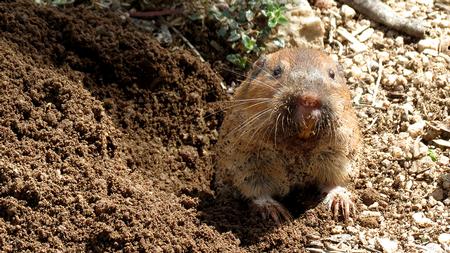Coping with gophers
-
If you see a favorite perennial suddenly wilting though you’ve been giving it plenty of water, a favorite shrub with a swath of yellow leaves covering half of the plant, or a nice little annual you planted recently has gone missing, gophers may be the culprit!

Gophers are small burrowing rodents that feed on roots of many types of plants. A single gopher can ruin a garden in a short time, and gopher gnawing can damage irrigation lines and sprinkler systems. In lawns, their mounds are unsightly and interfere with mowing. Early detection is critical to prevent damage. Combine the use of traps and underground fencing to manage gopher problems. Toxic baits are available but can pose threats to wildlife, pets, and children, especially in backyard situations.
Keep your eye out for gopher mounds
- Gophers spend almost all their time underground in their burrow and are not commonly seen.
- Look for mounds of loose dirt that are half circles or crescent-shaped with a plugged hole that is off to one side of the
- Fresh mounds are the sign of an active A single gopher can create several a day.
- In contrast to gopher mounds, mole mounds are circular with a plug in the middle and ground squirrel holes are unplugged without a mound.
Protect plants with underground fencing
- Lay hardware cloth or 3/4-inch mesh poultry wire under raised beds before
- Wire baskets to protect individual shrubs or trees can be installed at planting, leaving enough room for roots to
Use traps to reduce the gopher population
- Gopher traps are placed underground inside the gopher burrow, so you must use a gopher probe to locate the
- Be sure to place traps in active burrows as indicated by fresh mounds.
- Two common types of traps are pincer traps and box
- Set traps in tunnels in pairs facing each
- Cover the hole so light does not get
- Check traps often and reset as
- Keep trapping until no new mounds are
- Gopher traps do not require food
Avoid products and methods that are not proven
- Although many predators feed on gophers, installation of owl boxes is unlikely to reduce gopher numbers enough to prevent damage.
- No repellents currently sold successfully protect plants from
- Plants such as gopher purge, castor bean, and garlic have not been shown to repel gophers from an
- Frightening devices such as vibrating stakes, ultrasonic devices, and wind-powered pinwheels have not been effective in research trials.
- Fumigation with smoke or gas cartridges is not effective because gophers can seal off their burrows

